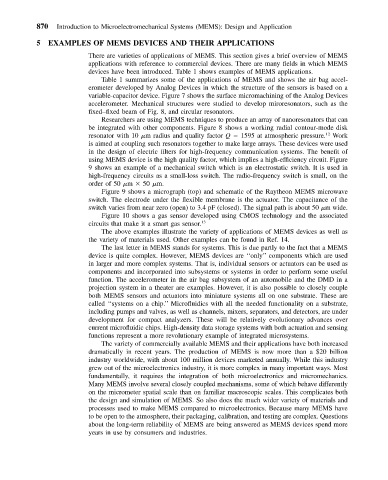Page 879 - Mechanical Engineers' Handbook (Volume 2)
P. 879
870 Introduction to Microelectromechanical Systems (MEMS): Design and Application
5 EXAMPLES OF MEMS DEVICES AND THEIR APPLICATIONS
There are varieties of applications of MEMS. This section gives a brief overview of MEMS
applications with reference to commercial devices. There are many fields in which MEMS
devices have been introduced. Table 1 shows examples of MEMS applications.
Table 1 summarizes some of the applications of MEMS and shows the air bag accel-
erometer developed by Analog Devices in which the structure of the sensors is based on a
variable-capacitor device. Figure 7 shows the surface micromachining of the Analog Devices
accelerometer. Mechanical structures were studied to develop miroresonators, such as the
fixed–fixed beam of Fig. 8, and circular resonators.
Researchers are using MEMS techniques to produce an array of nanoresonators that can
be integrated with other components. Figure 8 shows a working radial contour-mode disk
12
resonator with 10 m radius and quality factor Q 1595 at atmospheric pressure. Work
is aimed at coupling such resonators together to make large arrays. These devices were used
in the design of electric filters for high-frequency communication systems. The benefitof
using MEMS device is the high quality factor, which implies a high-efficiency circuit. Figure
9 shows an example of a mechanical switch which is an electrostatic switch. It is used in
high-frequency circuits as a small-loss switch. The radio-frequency switch is small, on the
order of 50 m 50 m.
Figure 9 shows a micrograph (top) and schematic of the Raytheon MEMS microwave
switch. The electrode under the flexible membrane is the actuator. The capacitance of the
switch varies from near zero (open) to 3.4 pF (closed). The signal path is about 50 m wide.
Figure 10 shows a gas sensor developed using CMOS technology and the associated
circuits that make it a smart gas sensor. 13
The above examples illustrate the variety of applications of MEMS devices as well as
the variety of materials used. Other examples can be found in Ref. 14.
The last letter in MEMS stands for systems. This is due partly to the fact that a MEMS
device is quite complex. However, MEMS devices are ‘‘only’’ components which are used
in larger and more complex systems. That is, individual sensors or actuators can be used as
components and incorporated into subsystems or systems in order to perform some useful
function. The accelerometer in the air bag subsystem of an automobile and the DMD in a
projection system in a theater are examples. However, it is also possible to closely couple
both MEMS sensors and actuators into miniature systems all on one substrate. These are
called ‘‘systems on a chip.’’ Microfluidics with all the needed functionality on a substrate,
including pumps and valves, as well as channels, mixers, separators, and detectors, are under
development for compact analyzers. These will be relatively evolutionary advances over
current microfluidic chips. High-density data storage systems with both actuation and sensing
functions represent a more revolutionary example of integrated microsystems.
The variety of commercially available MEMS and their applications have both increased
dramatically in recent years. The production of MEMS is now more than a $20 billion
industry worldwide, with about 100 million devices marketed annually. While this industry
grew out of the microelectronics industry, it is more complex in many important ways. Most
fundamentally, it requires the integration of both microelectronics and micromechanics.
Many MEMS involve several closely coupled mechanisms, some of which behave differently
on the micrometer spatial scale than on familiar macroscopic scales. This complicates both
the design and simulation of MEMS. So also does the much wider variety of materials and
processes used to make MEMS compared to microelectronics. Because many MEMS have
to be open to the atmosphere, their packaging, calibration, and testing are complex. Questions
about the long-term reliability of MEMS are being answered as MEMS devices spend more
years in use by consumers and industries.

